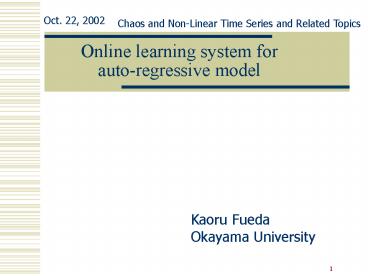Online learning system for autoregressive model - PowerPoint PPT Presentation
1 / 34
Title:
Online learning system for autoregressive model
Description:
Chaos and Non-Linear Time Series and Related Topics. Kaoru Fueda. Okayama University ... Example of chaos. Henon map. 9. Chaotic time series with dynamic noise. 10 ... – PowerPoint PPT presentation
Number of Views:32
Avg rating:3.0/5.0
Title: Online learning system for autoregressive model
1
Online learning system for auto-regressive model
Oct. 22, 2002
Chaos and Non-Linear Time Series and Related
Topics
Kaoru Fueda Okayama University
2
Abstract
- For analysis of non-linear auto-regressive time
series model, Fueda and Yanagawa(2001) gives the
consistent estimator of the order and other
parameter of auto-regressive model. Today we make
improvements for their method.
3
Abstract
- To estimate the non-linear auto-regressive
function, we need a large number of sample from
long term observation. In real data, the
auto-regressive function might change slightly in
a long term, even if it seems to be stationary
for a short term. Our method adapts such slight
change by on-line learning system.
4
Non-linear auto regressive model
- We consider the stochastic mode given by
specially whose deterministic skeleton
makes chaotic model.
5
What is chaos
- Chaos is a complex system made by iteration of a
simple function.
- Locally it expands small differences, but
globally bounded.
6
The aim of research
- To estimate the simple function to be iterated
instead of the complex function made by
iteration. - To estimate derivatives of the simple function to
check that it expands small differences.
7
What is dynamic noise
- It may change the orbit Xt completely due to
expansion of a small difference. - Cf. observation noise doesnt change the orbit.
8
Example of chaos
- Henon map
9
Chaotic time series with dynamic noise
10
Chaotic time series with dynamic noise
11
Previous researches
- For non-linear auto-regressive time series model
- Cheng and Tong(1994) has proposed estimators of
F and d using Nadaraya-Watson kernel estimator
and cross validation method. - For non-linear auto-regressive time series model
with delay time
Fueda and Yanagawa(2001) has proposed estimators
of F,d and t, and proved their consistency.
12
Fueda and Yanagawa(2001)
13
Fueda and Yanagawa(2001)
14
Fueda and Yanagawa(2001)
15
Yonemoto and Yanagawa(2001)
- Yonemoto and Yanagawa(2001) pointed out that
Fueda and Yanagawa method often fails to estimate
the true d0 and t0. - They proposed a new criterion, and confirmed
their criterion works well by simulation.
16
Yonemoto and Yanagawa(2001)
17
Conditions on the bandwidth h
- Fueda and Yanagawa(2001) needs some conditions on
bandwidth h to get consistency of estimator. For
example,
- Yonemoto and Yanagawa(2001) choose h to minimize
CV(t,t) for each t,t .
18
Multivariate local linear regression
- Since the kernel estimator has bias at the bounds
of data point, Fueda(2001) has proposed a
estimator of F,d and t based on the local linear
regression and bias correction.
19
Multivariate local linear regression
20
Multivariate local linear regression
- We may write D(ß, z, X) as a matrix form
21
Multivariate local linear regression
- D(ß, z, X) is minimized by
and estimators of F and its derivatives are given
by
22
Model selection
- For each d and t, put
23
Multivariate local linear regression
- By this method, we can estimate F(z).
- But often fail to estimate its derivatives.
24
Difficulty in this estimation
- Henon map
- zF(y,x)
Available data points(x,y)
25
Difficulty in this estimation
- Available data points
26
Dimension of data points
- Dimension of data point of chaotic time series is
a non-ingegre Fractal dimension. - Definition of Fractal dimension(Grassberger and
Procaccia(1983))
27
Locally ill condition
- Then we introduce PCA to local linear regression,
and select variables adaptively.
28
Principal Component Analysis
- For Locally weighted design matrix
29
Locally weighted PCA
- For such matrix V, we may rewrite
30
Adaptive variable selection
31
Adaptive variable selection
- Then D(ß, z, X) is minimized by
32
Adaptive variable selection
33
Adaptive autoregressive model
- To estimate the non-linear auto-regressive
function, we need a large number of sample form
long term observation. In real data, the
auto-regressive function F might slightly change
in a long term, even if it seems to be stationary
for a short term. Thus we introduce the on-line
learning (or forgetting) system to adapt such
data.
34
Adaptive autoregressive model
- For non-parametric case































